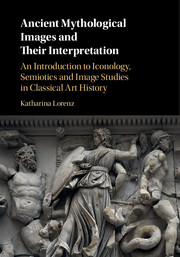 Ancient Mythological Images and their Interpretation
Ancient Mythological Images and their Interpretation Book contents
- Frontmatter
- Dedication
- Contents
- List of figures
- Preface
- The experiment: methods – images – objects
- ICONOLOGY
- SEMIOTICS
- IMAGE STUDIES
- 7 Introducing image studies
- 8 Image studies in action
- 9 Narratives of space and perspective
- 10 The study of mythological images as threesome – assessing the experiment
- Bibliography
- Index
9 - Narratives of space and perspective
from IMAGE STUDIES
Published online by Cambridge University Press: 05 August 2016
- Frontmatter
- Dedication
- Contents
- List of figures
- Preface
- The experiment: methods – images – objects
- ICONOLOGY
- SEMIOTICS
- IMAGE STUDIES
- 7 Introducing image studies
- 8 Image studies in action
- 9 Narratives of space and perspective
- 10 The study of mythological images as threesome – assessing the experiment
- Bibliography
- Index
Summary
Image studies as experiment: the results
Image studies focuses on a picture's share in negotiating – and shaping – reality, that is, on its functional aspects and the logistics of its display. At the stage of spatial analysis, the case studies demonstrate the strength of image studies in its scrutiny of the compositional design of a picture by highlighting certain features from specific viewpoints, which creates varying perspectives on the picture as an artefact. In combining elements of the syntactic assessment of semiotics with iconology's iconography, this stage appropriates these elements in a new way. While semioticised syntactics is concerned with the internal structure of a picture, and iconological iconographics with the external connection between individual motifs within the picture and other such motifs in other pictures, image studies occupies a middle ground with its consideration of the internal structures of a picture as shaped by their perception.
At this stage, everything in and around the picture is under scrutiny: the elements that make the depiction as well as the empty spaces around them, both within the picture and within its immediate environment. That approach is firmly rooted in semioticised reception aesthetics, and in narratology more generally. Additionally, it emulates those interpretive mechanisms in a spatio-physical approach within which the focus is on the performativity of the picture and on what is on display at different points in the picture's use: the ‘what’ of the picture as presented through the ‘how’ of its physical display.
In the case of the Karlsruhe hydria, this approach reveals any blind spots created by the heterogeneous arrangement of the two pictorial areas and considers how these areas would have been perceived whilst the pot was lifted, tilted, or turned. It also highlights the visual connections established across the two pictorial zones. With regard to the Pergamon altar, it throws into relief the compositional arrangement of the Great Frieze along the stairs and reveals the display as the endpoint of the various compositional strategies that have been devised to anchor the depiction within the sphere of its audience and that serve to create a pervasive experience of the narrative as a whole. Similarly, for the Louvre sarcophagus, the focus on spatial design establishes a specific take on narrative sequence as played out on the casket.
- Type
- Chapter
- Information
- Ancient Mythological Images and their InterpretationAn Introduction to Iconology, Semiotics and Image Studies in Classical Art History, pp. 224 - 235Publisher: Cambridge University PressPrint publication year: 2016
